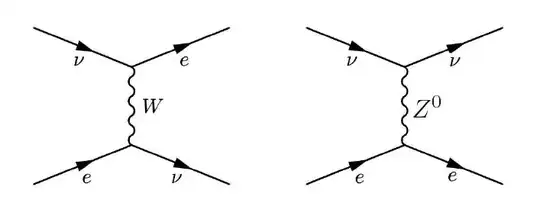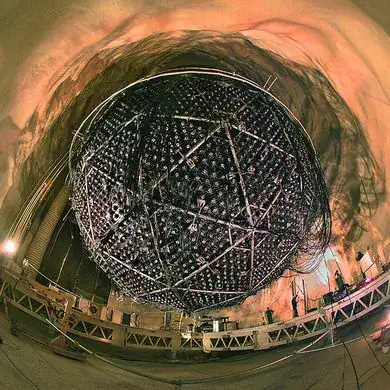I understand that particles interact via the fundamentals forces of nature. For example photons interact with matter because they carry the change in the electromagnetic field. Neutrinos, on the other hand, do not interact with the electromagnetic field, and so go through matter with (almost) no interaction. However neutrinos still have a size (and a mass), so can a neutrino "hit" an electron (which also has a size) though unlikely that is? Since neutrinos do not interact with the electromagnetic field, they would not be deflected, so can two particles, like a neutrino and an electron, hit "head-on"?
-
2Of some relevance: https://physics.stackexchange.com/q/23797/ – dmckee --- ex-moderator kitten Sep 25 '17 at 04:08
-
1I think this answer is also somewhat relevant: https://physics.stackexchange.com/a/359015/38055 It talks about interactions of photons and neutrinos with matter. There are interesting numbers invoked and conclusions drawn. – luk32 Sep 25 '17 at 19:48
3 Answers
Yes, neutrinos "hit" electrons all the time inside the sun, on their way to getting out, which results into the resonant conversion of their flavor, predicated on the changing effective index of refraction. They interact with electrons, and protons, and neutrons, etc... through their favorite interaction, the weak , not electromagnetic interaction. (They can also interact through the puny gravitational interaction, for them.)
They are detected on earth through their (rare) weak interactions with nucleons in the detectors built for that very purpose. Your "head on collision" metaphor would hardly apply for any particle, let alone neutrinos. (For all practical purposes, particles, indeed, never quite hit each other. "Hit each other" is a useful shared metaphor to summarize an interaction, quite well described mathematically by Quantum Field Theory. At some point, taking the metaphor to be more "real" than an informal summary of the math will lead you astray and inflict conceptual casualties.)
In any case, talking about the "size" of neutrinos and electrons makes very little sense. You may wish to think of their inverse mass, their Compton wavelength (which, for the ν, would exceed 0.1 μm ) as some sort of a "size", but you are likely to run into nasty absurdities unless you were very-very careful.
- 62,595
-
-
2That's the point: a cross section with units of area quantifies likelihood of interaction given a flux of particles, and depends on the strength of the interaction involved... you may conjure up intuitive pictures if you are careful, as long as you don't end up confusing yourself.. – Cosmas Zachos Jul 08 '18 at 20:29
-
Well an electron and a neutrino can barely interact with each other. The weak force is too weak and the Z bosons and W bosons are too massive. But it can happen you are right, just barely happens. Also it has nothing to do with size. Elementary particles do not have size. They can have it only if the Heisenberg's uncertainty principle allows it but elementary particles are said to have zero size. Only interactions between particles results in size. – MiltonTheMeme May 18 '20 at 14:22
-
The weak force is weak, but not "too weak": the sun burns on it. You misunderstood the definition of effective size defined here. The Compton wavelength is obviously defined through the UP. Please read up. – Cosmas Zachos May 18 '20 at 14:33
- 59,560
-
2So, again, this is not a "head-on" hit, it is a weak interaction, they exchange a W or Z boson. Can two particles ever hit each others like two balls? What happens in the LHC? – user Sep 24 '17 at 23:36
-
15Particles never hit each other like balls. In the LHC, particles are sped up close to the speed of light. Then by a well known formulation of the uncertainty principle, $\Delta E\Delta t\ge \hbar/2$, when the wave functions of particles coming in opposing directions interact the within some small $\Delta t$, $\Delta E$ effectively becomes large enough for particle production. This is a extremely simplified explanation for what happens at the LHC. – Dhuality Sep 24 '17 at 23:43
-
17@user, you state in your post that "I understand that particles interact via the fundamentals forces of nature." but your comment above contradicts, in a profound way, that statement. – Alfred Centauri Sep 25 '17 at 02:28
-
5@Aditya That "well known formulation fo the uncertainty principle" is actually a myth that does not exist in the actual physical formalism. For the correct interpretations of what $\Delta t$ and $\Delta E$ mean in the "time-energy uncertainty principle", see this answer by joshphysics. – ACuriousMind Sep 25 '17 at 10:09
-
5AlfredCentauri "I understand that ..." is a different statement to "I understand how ..." I'm guessing that @user has been told that particle interactions are mediated by fundamental forces, but doesn't necessarily understand all the implications of that. – R.M. Sep 25 '17 at 15:28
-
@R.M., I understand that, according to the Standard Model, particle interactions (fundamental forces) are mediated by gauge bosons but I confess that I do not (yet) understand how. QFT is still quite mysterious to me despite a long running effort (years) to grok it. – Alfred Centauri Sep 26 '17 at 00:24
-
1@AlfredCentauri Of course my understanding is not vey deep, or I would not have asked this question – user Sep 26 '17 at 23:52
That both the neutrino and the electron have mass, is not a reason for them to interact. In general, having (rest) mass or not, is not a reason for interact or not interact. Also the photons interact.
Our mechanical intuition, that things are colliding like snooker balls, exists only in the macro-world. In ordinary matter, there is a
- Pauli-exclusion principle
- and an electromagnetic interaction
between the particles of the macro-sized bodies.
However, both the neutrino and the electron is charged on the weak interaction, and this may make them interacting. Actually, even neutrino detectors can be built on this principle. This is the Sudbury Neutrino Observatory, and it works partially on this way.
You can find more by googling for "neutral current neutrino detectors".
- 8,208

